A Telegraph tour of the English high street: Fishergate, Preston – much friendlier than I’d expected
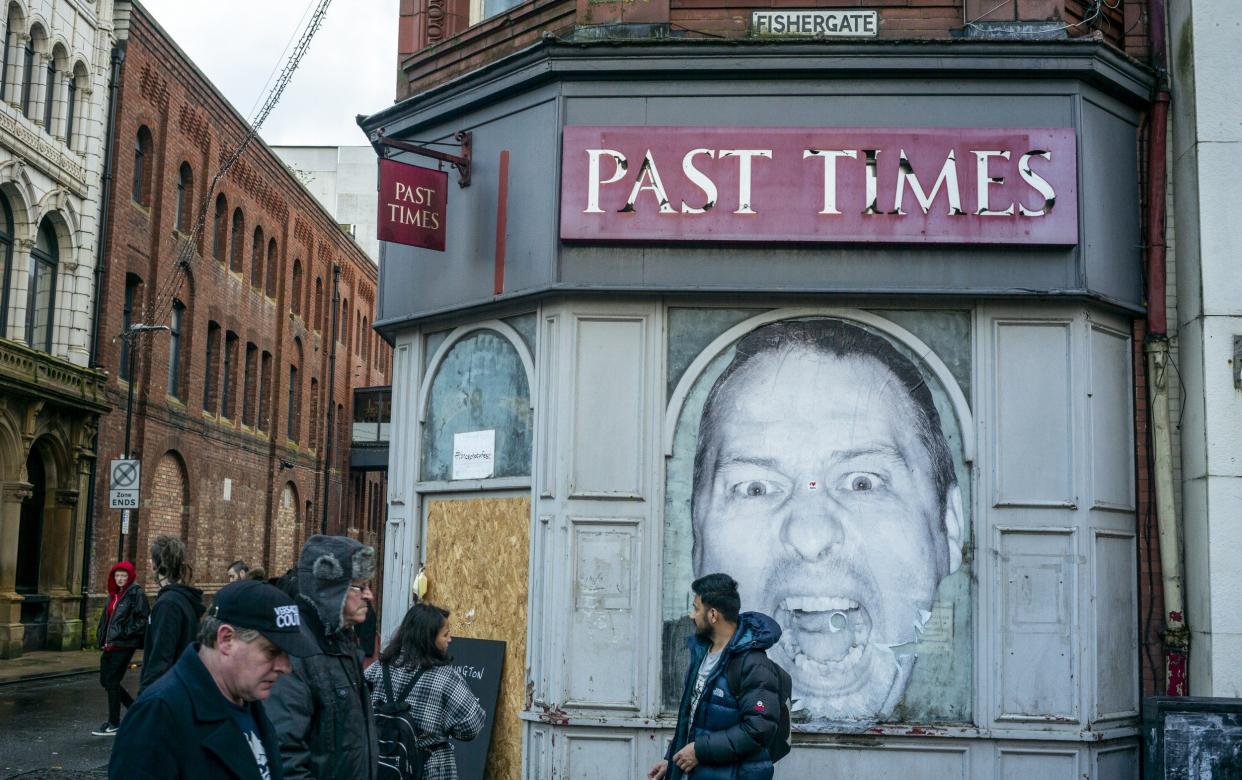
The traditional British high street was, for so many, the beating heart of their town. But as huge chains consumed spaces once filled by local independent businesses – and struggling firms began to disappear entirely – was the soul of our towns lost? Christopher Howse is travelling the nation to speak to local people about their high street. How it has changed, what they miss… and why there are still joys to be found. This week, Christopher takes a tour of Fishergate in Preston, Lancashire.
I felt much better after a cup of tea and a scone in Bob & Berts, a warm, bright, modern cafe at the station end of Fishergate, which serves as Preston’s high street.
I’d made the mistake of starting at Starbucks, which charged £7.10 for a meagre cheese toastie and a raspberry lemonade. A couple of young women in headscarves sat sadly at the next table.
Starbucks is in the Fishergate Shopping Centre and, with its neighbours Poundland, TK Maxx, Shoezone and McDonald’s, could be anywhere. The shopping centre also shelters the empty Debenhams department store with its big To Let sign. The shopping centre’s previous owners went into administration in 2013.
Preston, a city of 130,000 on the river Ribble, has a large park celebrated for egg-rolling or “pacing” at Easter and a proud industrial past. I must say immediately that Fishergate turned out to be much friendlier than I’d expected. I’d spent a drizzly time exploring the area just to the north of the station. It has a mixture of industrial decay, small houses with a strong presence of yet-to-be-prosperous people of south Asian origin and university accommodation.
I hadn’t realised that what I came to think of as “student farming” played such a prominent part in the life of English towns. The depressing hotel where I’d stayed – between a busy road and the railway – was identical to the student housing next to it – where the residents have to stay for more than a night or two.
But near the University of Central Lancashire stands one of the architectural marvels of Preston. (The other, beyond the east end of Fishergate, is the controversial 1960s Brutalist bus station.) Here, though, in the area called Maudland, with its strange-sounding street called Maudland Bank, is the exhilarating spire of St Walburge’s Church – 309ft high, the tallest parish church spire in the land. It was finished in 1854 to the design of Joseph Hansom, the man who invented the two-wheeled cab of the same name.
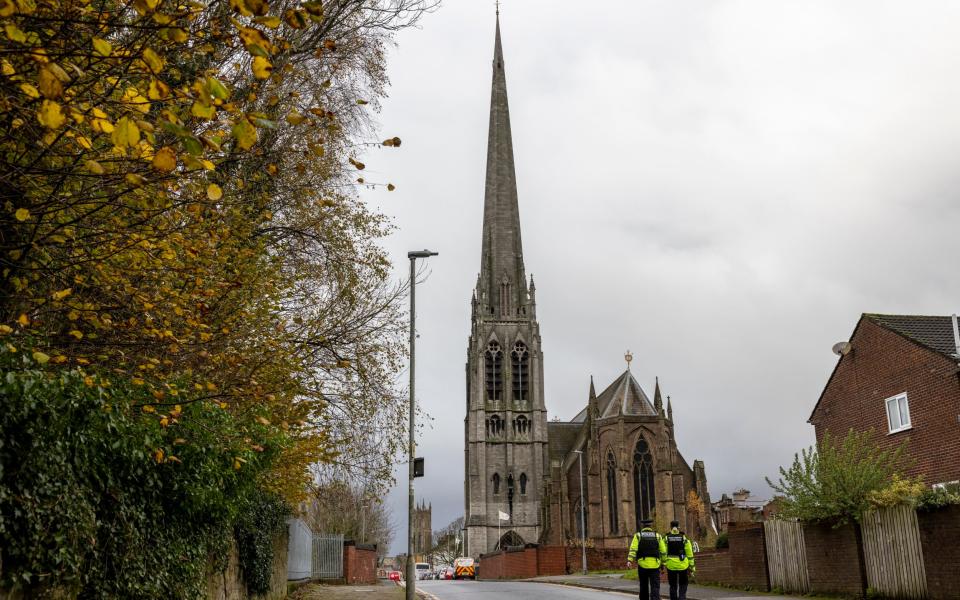
St Walburge’s has something in common with some older buildings in Fishergate. In 2007 its closure was threatened, but to what use could it be put to preserve it from ruin? Parishioners began a fundraising drive with a Lancashire Hotpot Supper, but it would have taken a lot of hotpots to maintain a whacking great church. Its future was only secured when it was taken on by the Institute of Christ the King, a bona fide Catholic set-up devoted to the Tridentine Mass.
The cafe Bob & Berts offered the more humble attraction of a loo plus Nine to Five and Take on Me sounding cheerily over the loudspeakers. I assumed the place was a local start-up, but it is in fact a modest chain originating in Northern Ireland, with half a dozen branches now in the North of England. When I congratulated the young woman at the counter on the free butter and jam available and the metal cutlery, she replied humorously, “That’s why people come here. You should come back.” I wouldn’t mind.
Shops close early by London standards. By six, Fishergate was deserted. One shop still open was the Sainsbury’s Local, which has found a new use for an old commercial building of some splendour, “the best building of its type in Preston” in the opinion of Pevsner’s Buildings of England.
The proud stone frontage in Renaissance style, with vermiculated rustication, animal masks gripping festoons and five bays of windows, with columns supporting classical pediments, was built in 1856 for the Preston Banking Company, formed to serve the growing prosperity of the town’s mills. The first manager, Henry Graves, lived above the shop.
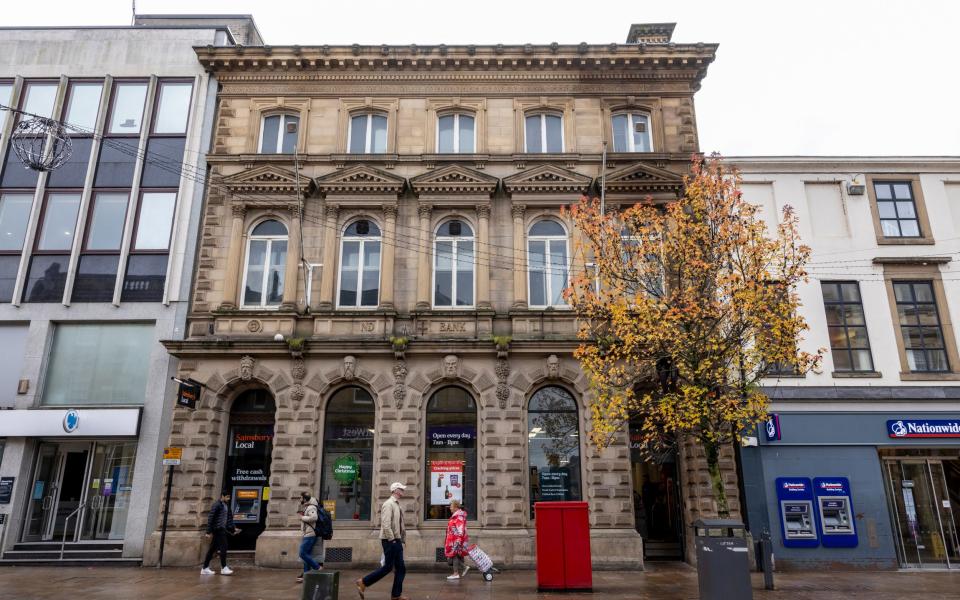
Sainsbury’s opened here in 2014, eight years after HSBC closed the bank branch; inside are rows of white-painted Corinthian pillars. That evening something had gone wrong with deliveries. “They’ve only got sliced bread and barm cakes,” complained one disappointed shopper.
Fishergate runs eastward from the railway station half a mile to the spire of St John’s, in what is by then Church Street. First recorded in 1094, the parish church was in 1853 unsentimentally pulled down and rebuilt, luckily to rather a fine design. Since Preston was made a city in 2002, it has been restyled as Preston Minster, as is the fashion for civic churches.
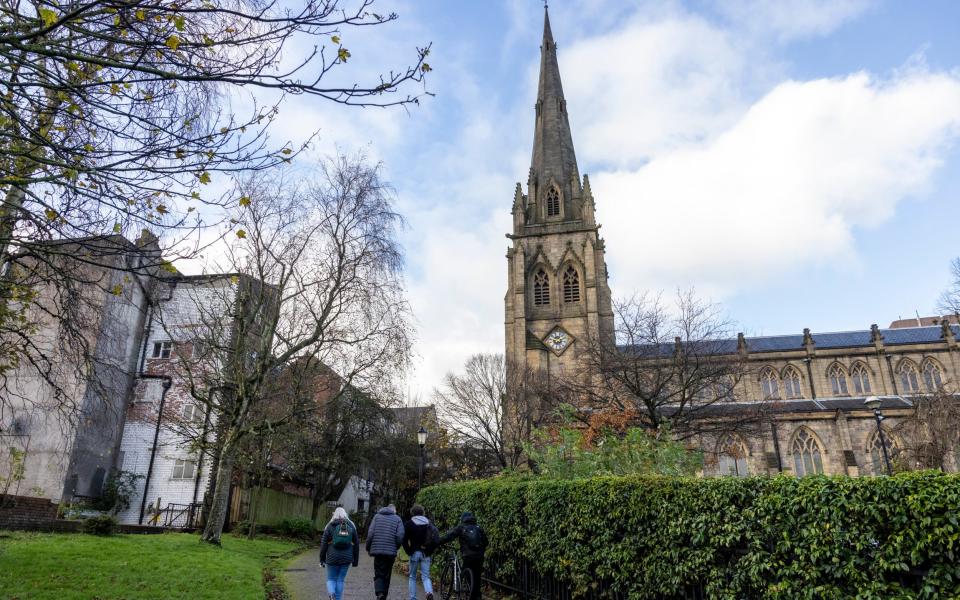
St John’s tall spire is a sort of lighthouse marking the eastward limit that Saturday morning shoppers are likely to wander, unless they feel a sudden need for vaping gear or a nail manicure amid decaying buildings. There used to be another spire defining Fishergate, 197ft high, on the town hall built of local stone in 1867 to the designs of Sir Gilbert Scott. It had all the magnificence a northern municipality could wish. An imperial staircase, only a little less grand than the architect’s Foreign Office in London, led to a first-floor Council Chamber and Guild Hall, spacious, stately and elaborately ornamented.
But 80 years later, on March 15 1947 a fire took hold, rushing up the tower and letting blazing beams of wood fall and strike the four-ton 15cwt bell, tolling weirdly in the night till it crashed down. The ground floor was patched up, and a petition of 8,000 called for the Town Hall’s restoration. But in 1962 it was demolished. Pevsner remarks with understatement that Crystal House, a block on a podium built in 1963, “is not a worthy successor”. Prestonians voted it their favourite building to be demolished.
As I mixed with the Saturday morning shoppers, a thin elderly man, sidling along the wall on the other side of the road, called out: “How are you, sir? I like your beard.” Under the canopy of the closed-down BHS, a man lay in a sleeping bag. Outside M&S a man asked for change. But the signs of rough-sleeping were nothing compared with my nightly walk home in central London.
The shoppers out and about had an air of prosperity. Fishergate is pleasant to walk down because it has been reduced to a single lane of sparse traffic. Some were bound for the Market Hall, purpose-built in 1973 on the site of a market centuries old.
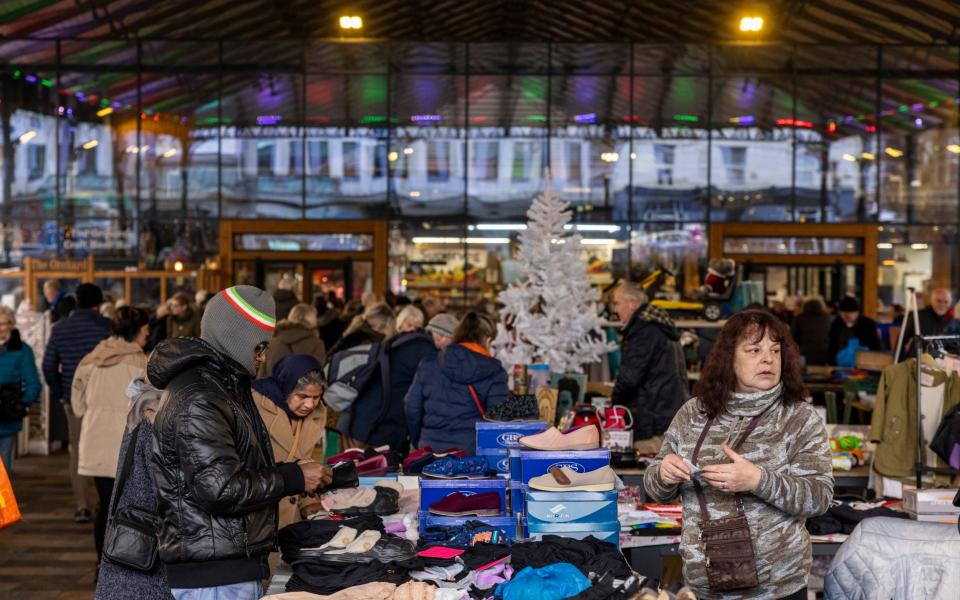
I liked the stall that sold wigs and sewing supplies and the cheese was a treat just to look at. The mackerel on the fish counter looked freshly painted but my favourite outlet, with a steady throng of shoppers, was Livesey’s the butcher’s. It offered the best roasting topside and bargains such as beef neck bones at four for £3 and pigs’ feet at £1.90 a kilo. A complicated piece of repartee between one of the butchers and a woman shopper in a woollen coat concerned bones that she was told she might see. “You shan’t be showing me anything,” she cried, roaring with laughter.
In the cooked section were piles of pies of every size: Gornal’s butter pies, Castle pork pies, Greenhalgh’s steak puddings, Manchester tarts.
Adrian Livesey has been running his shop for 40 years. He is well-built and ruddy as a butcher should be and wears a butcher’s hat, a striped apron and a big grin. “We’ve bucked the trend here at the market. People are getting skint nowadays,” he points out. “Instead of takeaways, I say, ‘Why don’t you have a go and cook?’” One thing he is worried about is parking for customers.
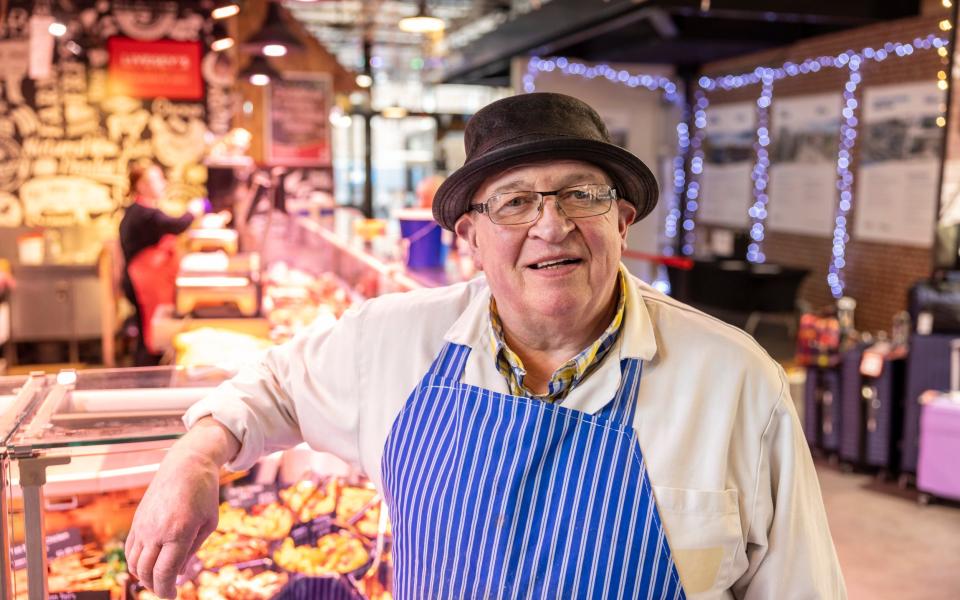
Nearby is the modern emblem of Preston, the Bus Station, built in 1968 and beloved by fans of Brutalism. It provided stands for 80 buses, 40 on each side of a long building beneath continuous car-park balconies resembling a giant hoover attachment.
One problem was pedestrian access through subways – smelly, dark and threatening. In 2012 it was decided to demolish it, but in 2013 it was listed as a building of architectural and historic interest.
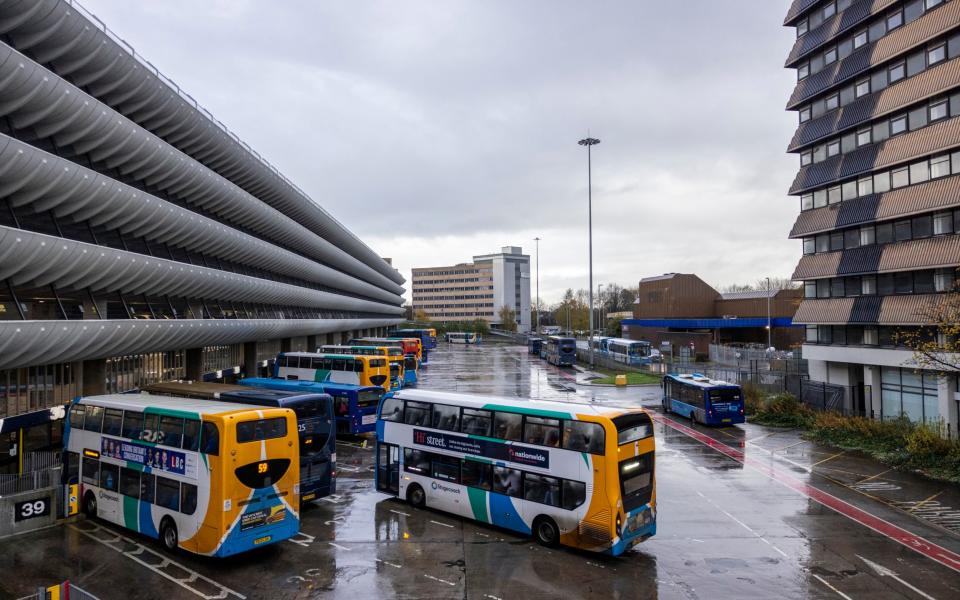
It has been improved by removing bus bays from one side and making a (windswept) square. The trouble now is planning blight. A £700 million development planned a decade ago has come to nothing, and the old Tithebarn pub which gave the scheme its name stands boarded up. In a back street nearby, graffiti, rubbish, abandoned bedding and vomit showed inner-city decay at its most repellent.
But Preston’s Fishergate remains a proud, historic, cheerful and enterprising high street less blighted than many with empty shops. Its future could be down or up.
Coming soon on Christopher’s tour of Britain’s high streets: High Street, Yarm, North Yorkshire... Shields Road, Byker, Newcastle (“Britain’s worst high street”)... Watergate Street, Chester... Abbeygate Street, Bury St Edmunds, Suffolk...

